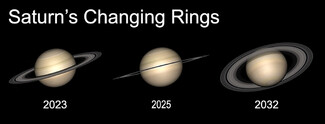Saturn's Changing Rings
Last updated 9/14/2023 at 12:02pm
Just about everyone's favorite planet is back in our evening sky once again. The ringed beauty Saturn reaches its "opposition" point in late August (officially on Aug. 27) when it appears as a fairly bright "star" that rises in the southeast at sunset and remains visible all night. You shouldn't have too much trouble spotting this distant world since it's now easily the brightest object in that part of the heavens. For additional help, keep in mind that the nearly full moon will appear near Saturn on the nights of Aug. 29 and 30.
Not only does a planet's opposition mean that it lies opposite the sun in our sky, but it also means it's closest to the Earth. This week, Saturn approaches within only about 814.6 million miles of our planet, and its larger apparent size produces a marvelous view through a telescope.
Even a small instrument with only a magnifying power of 30x or so will show its rings as well as Saturn's largest and brightest moon, Titan. Of course, viewing through a larger telescope with a higher magnification under good skies will show not only the planet's rings but also a break within them known as the Cassini division.
Saturn's rings have been known for nearly four centuries and, for most of that time, scientists debated their true nature. Today, because of high-tech astronomical instrumentation and spacecraft visits, we know that the rings are composed of chunks of ice and dust whirling around the planet at thousands of miles per hour.
A person's first view of the planet Saturn through a small telescope always elicits a gasp of wonder, as the remarkably three-dimensional ringed world appears suspended against the blackness of space. If you've never experienced this magnificent sight, now is the best time to do so, but you might want to wait until later in the evening when the planet is higher in the sky.
It may not appear like it when you see it, but Saturn's ring system is massive. Its diameter is about 170,000 miles, which means that if it were brought to the Earth, it would fill much of the space between our planet and the moon. Interestingly, however, this ring system is only a few hundred feet thick at most! Because these rings are tilted to their orbital plane, as Saturn revolves around the sun, we view them from different angles, causing them to take on dramatically different appearances over the years.
Since the rings are tilted at a 26.7-degree angle to the Earth, when Saturn's poles are tilted towards the sun and Earth, the rings appear "open" at their widest. The next time this happens will be in 2032.
And because the rings are so thin, when they're edge-on to us they nearly vanish, leaving only a tiny, faint and nearly featureless yellowish-white disk. Sometimes we can see them as a very thin line crossing the planet. Looking at these paper-thin rings from the side is an advantage to astronomers, though, since it removes their glare and gives us a great opportunity to see the icy moons near the planet. This will happen again in 2025.
Visit Dennis Mammana at dennismammana.com.




